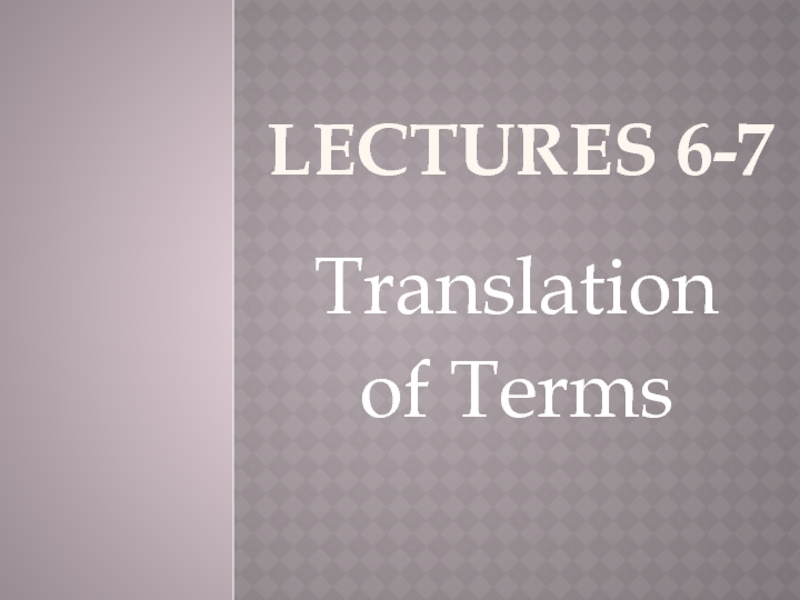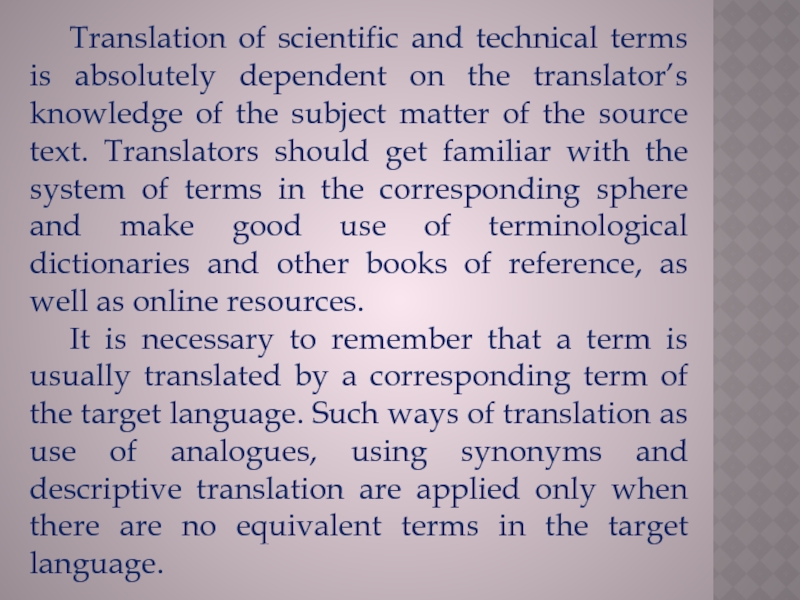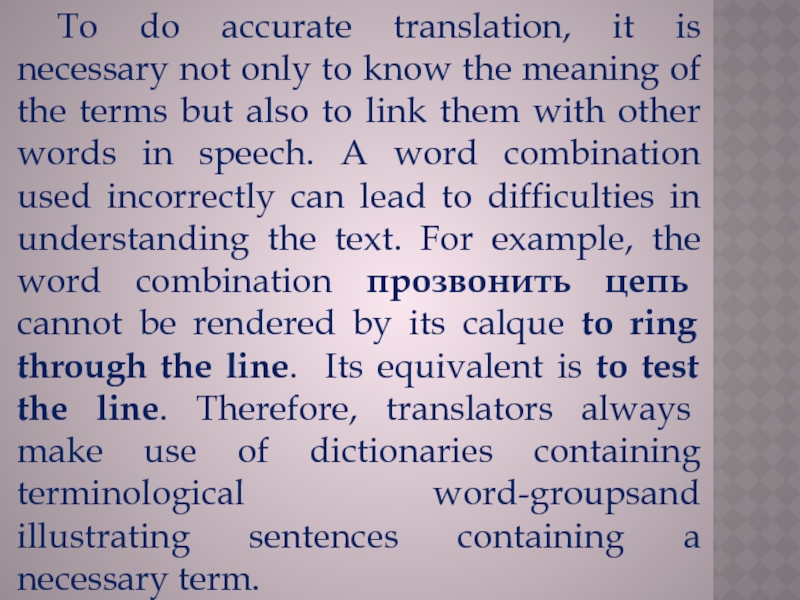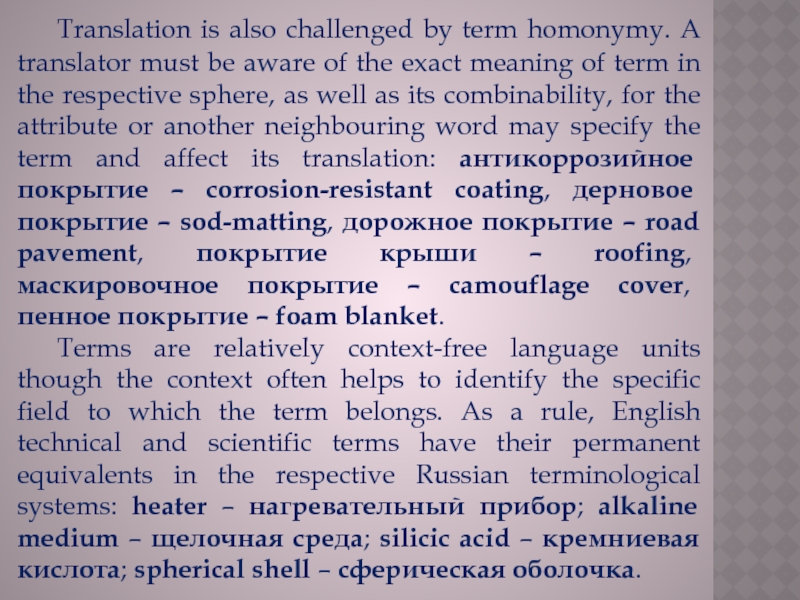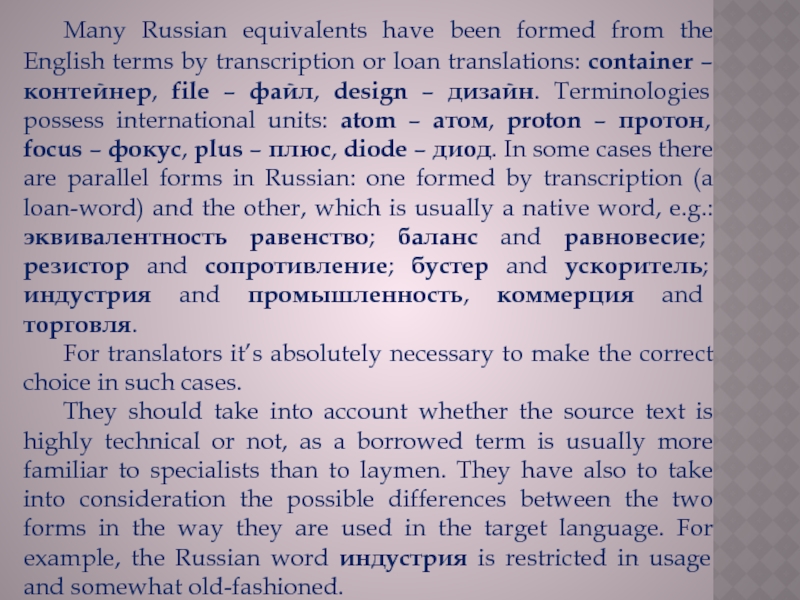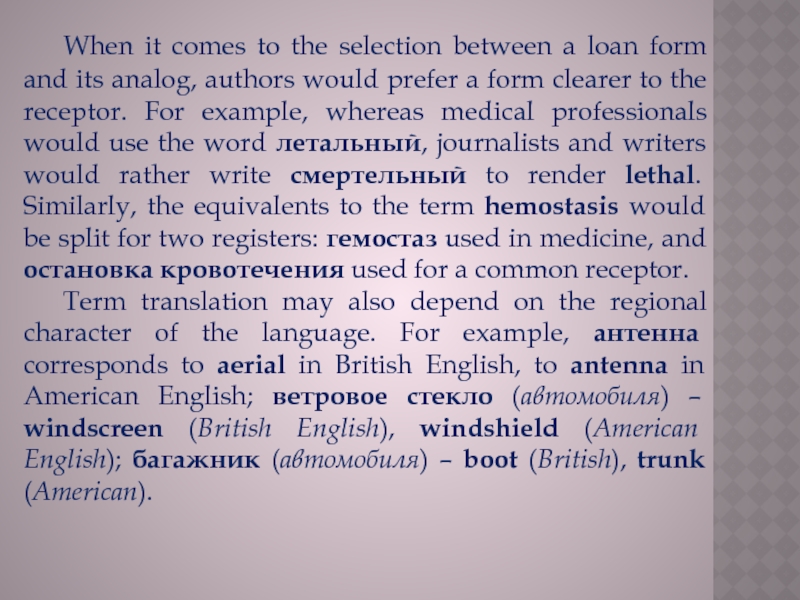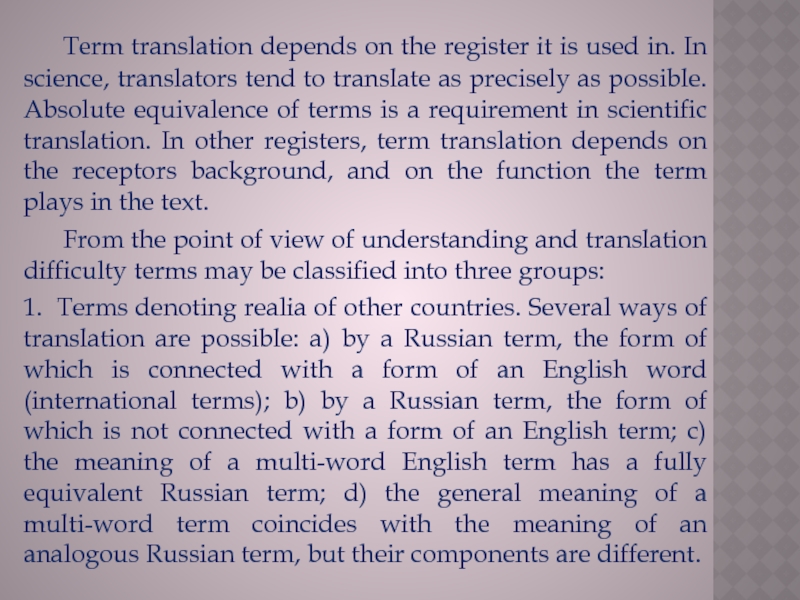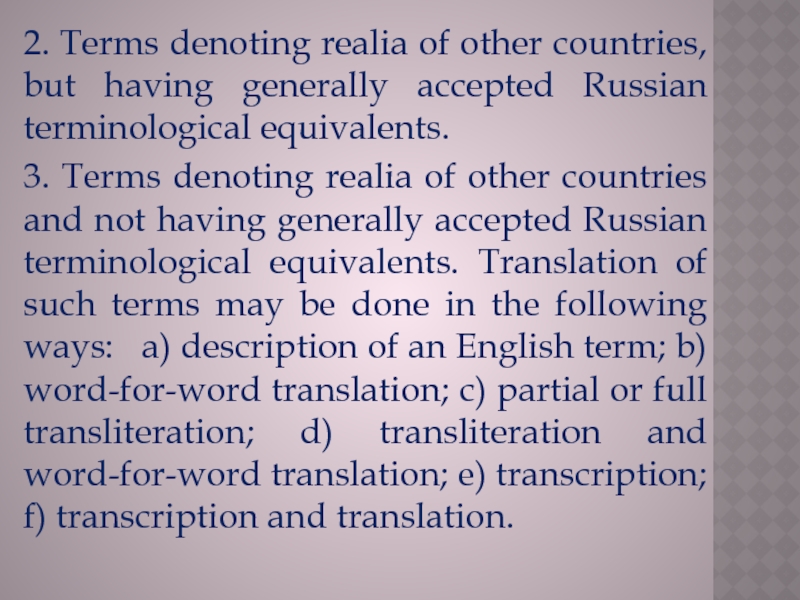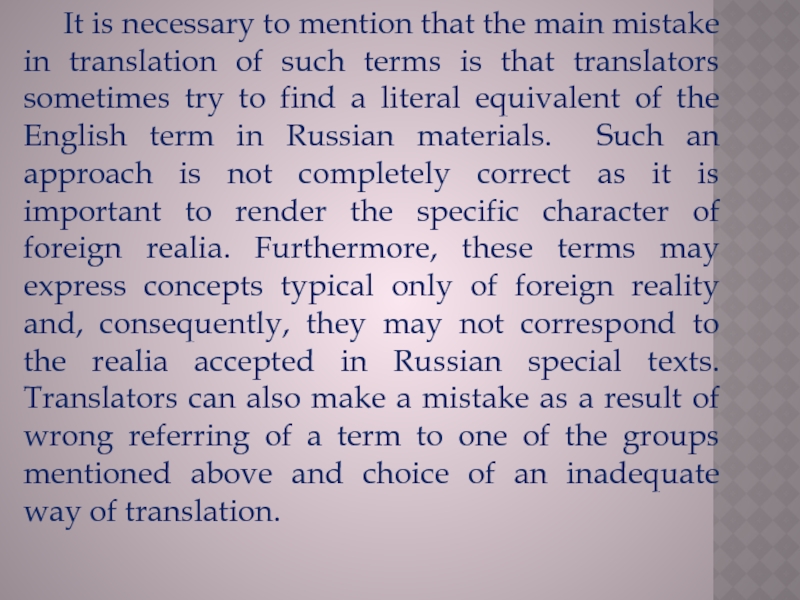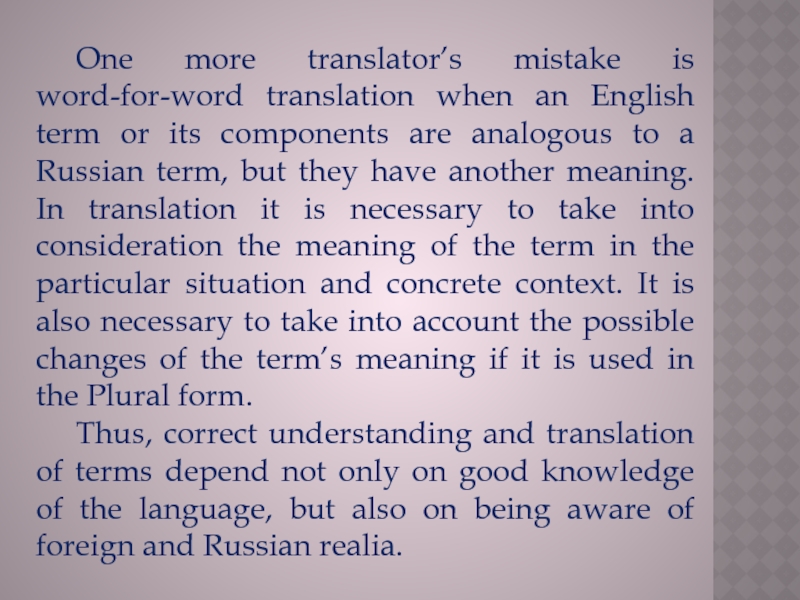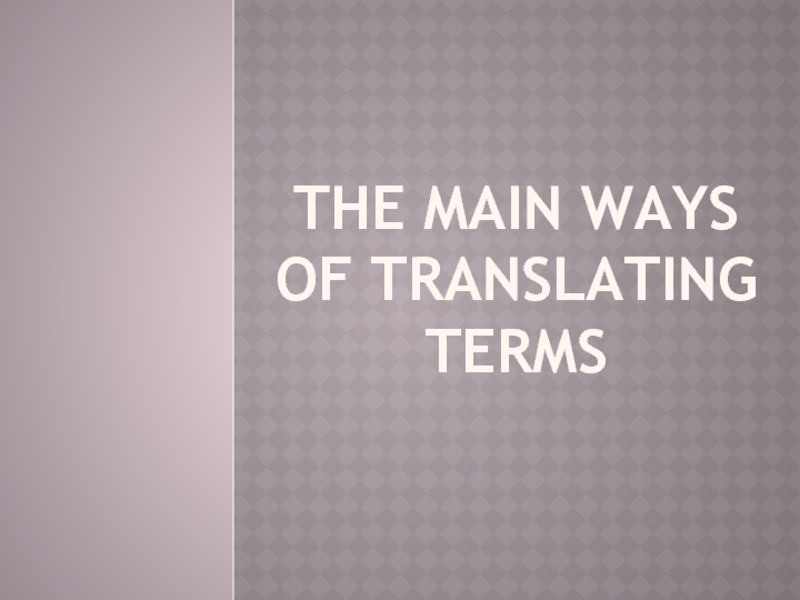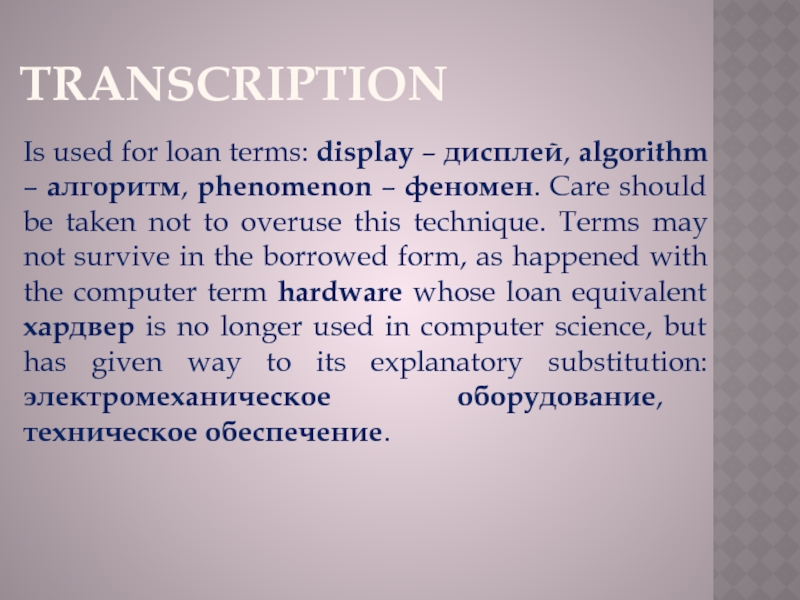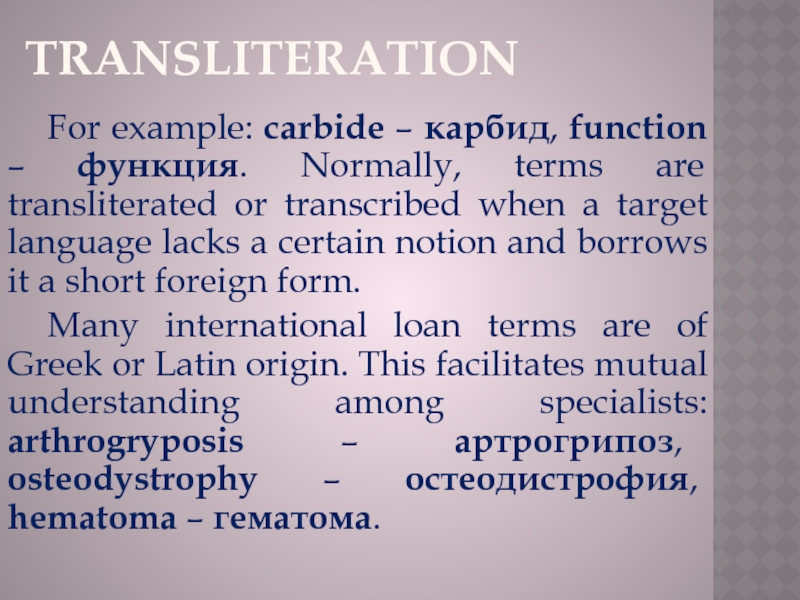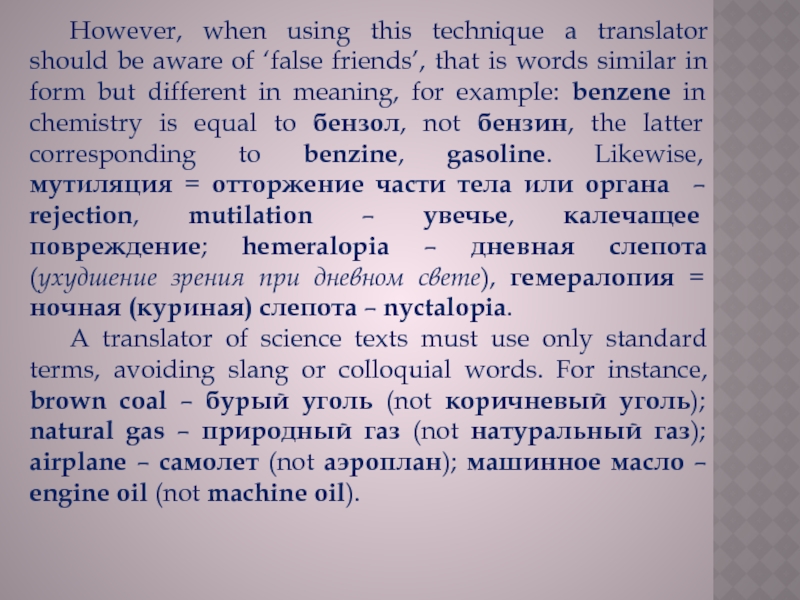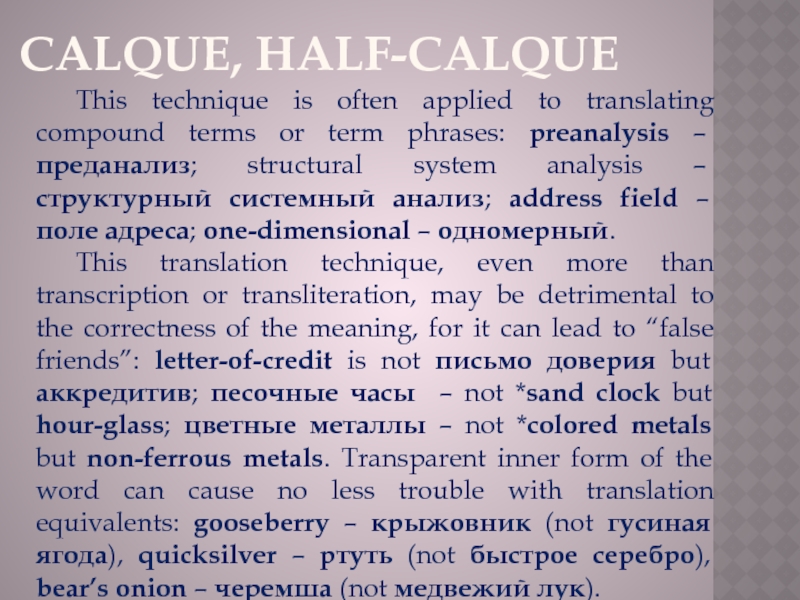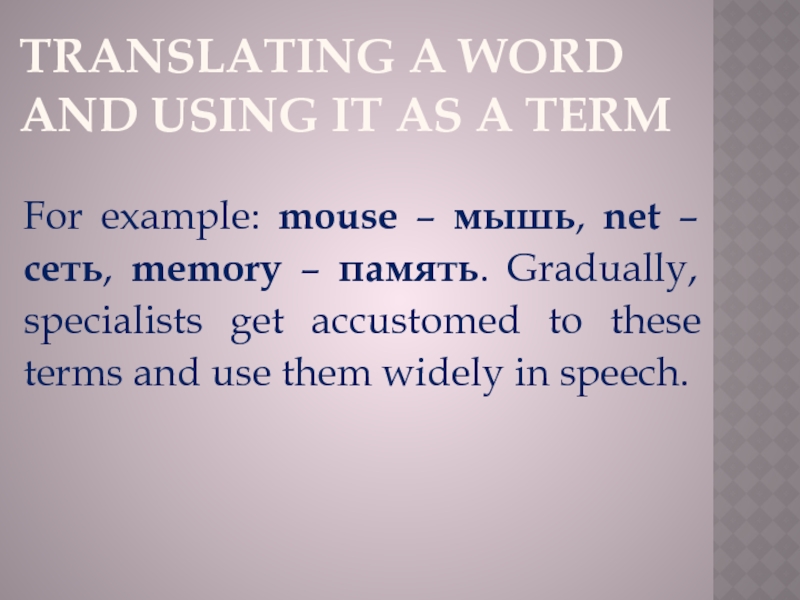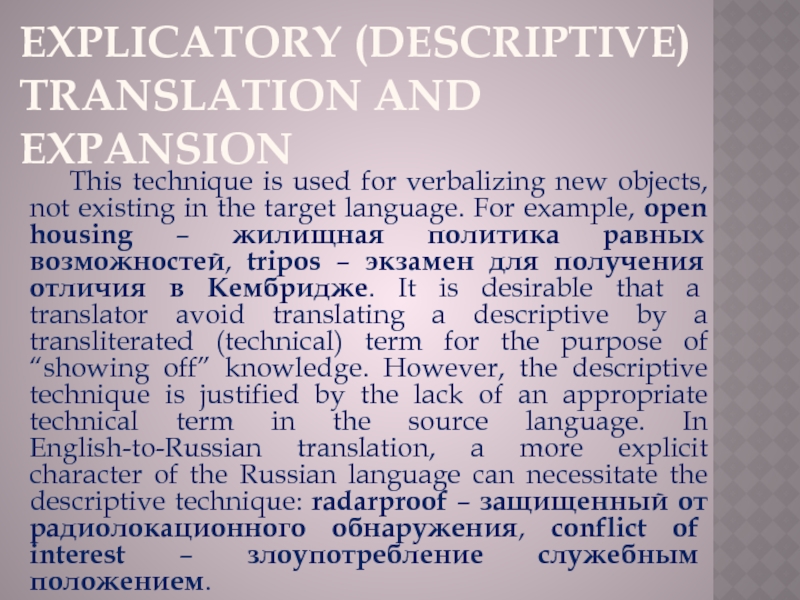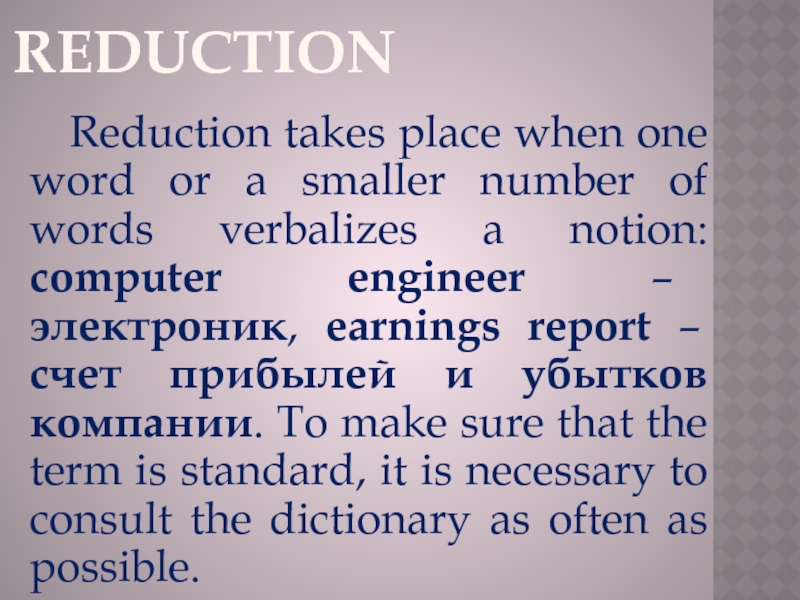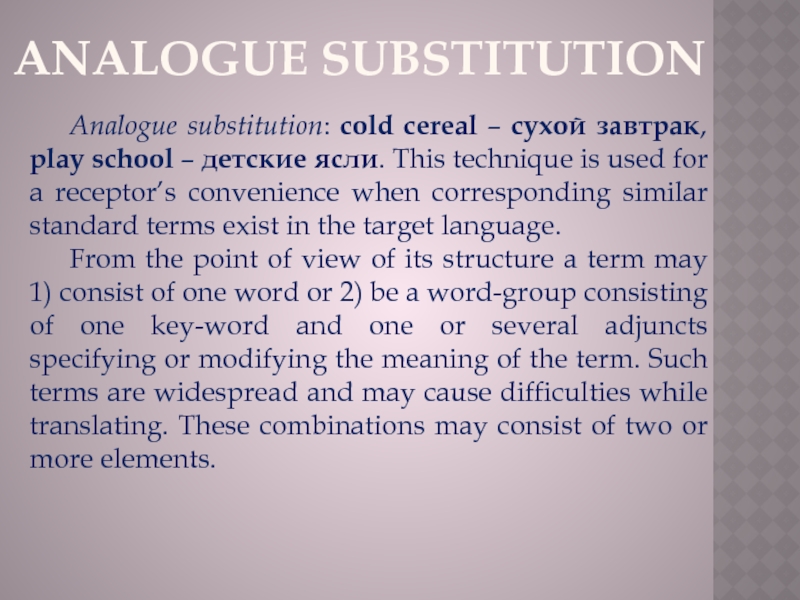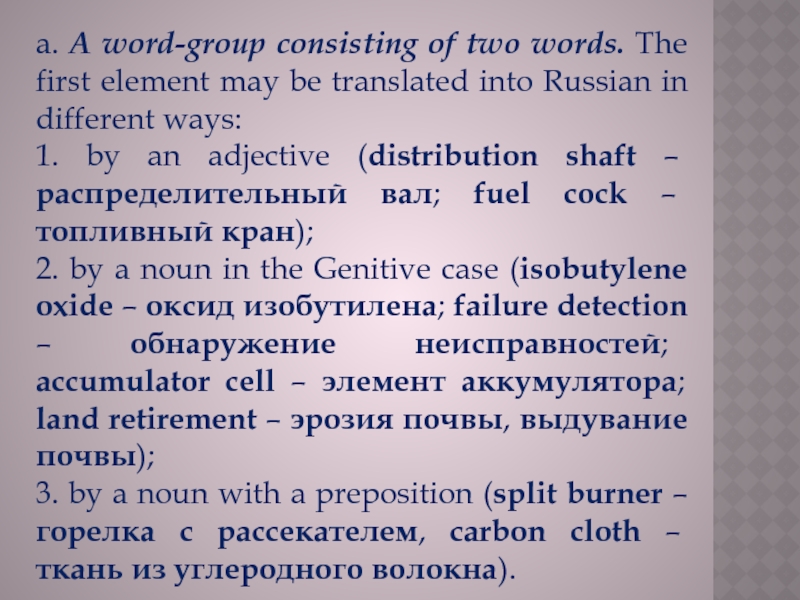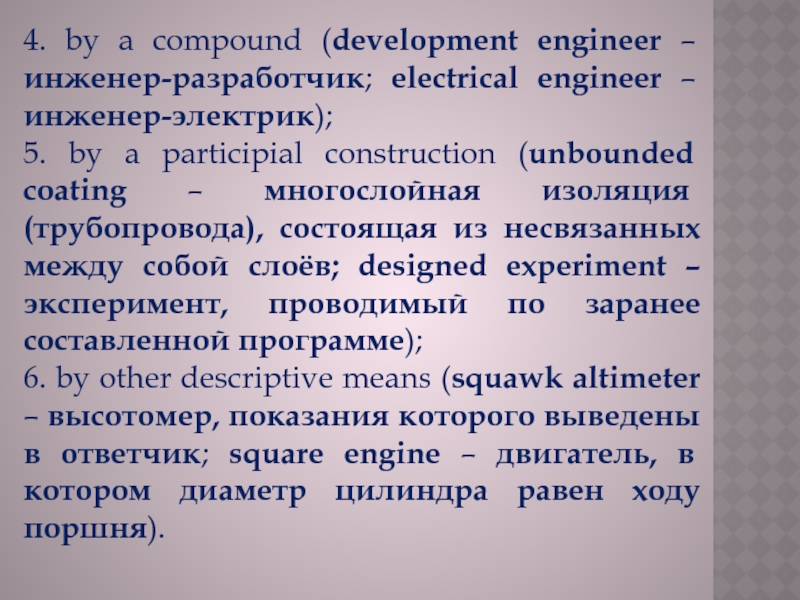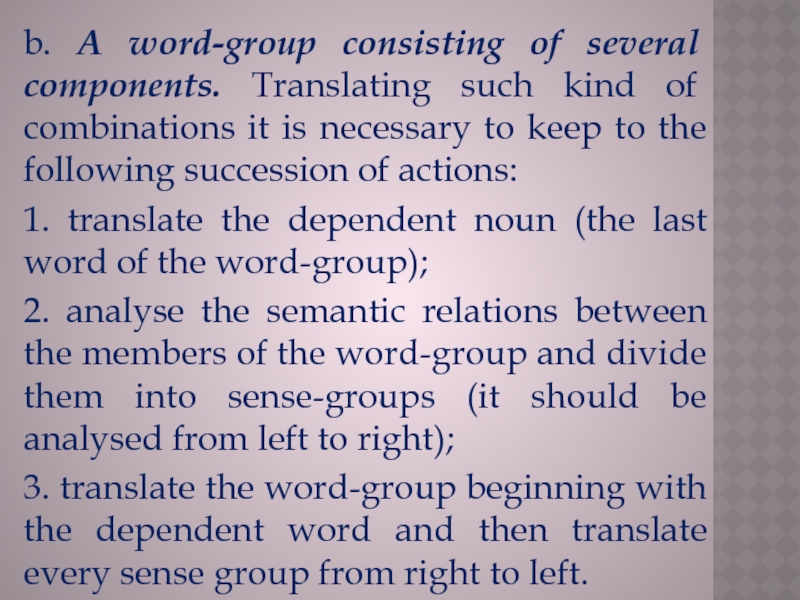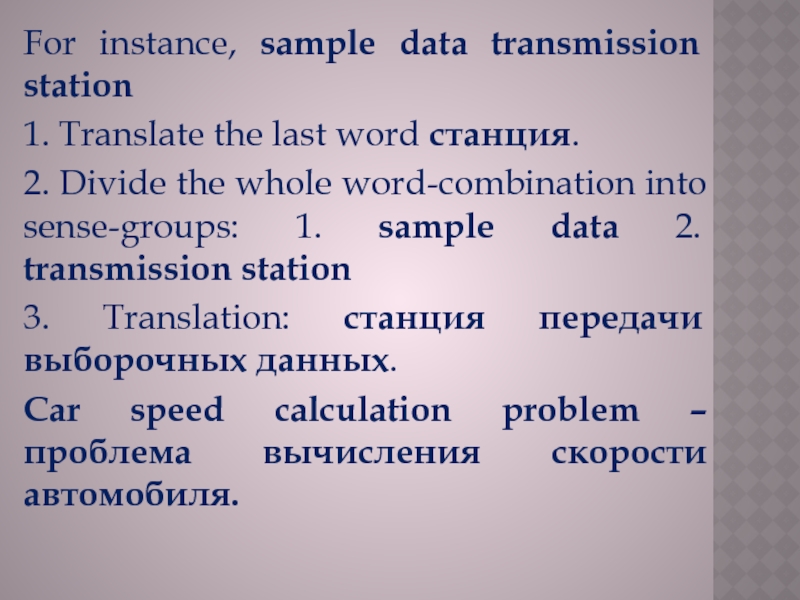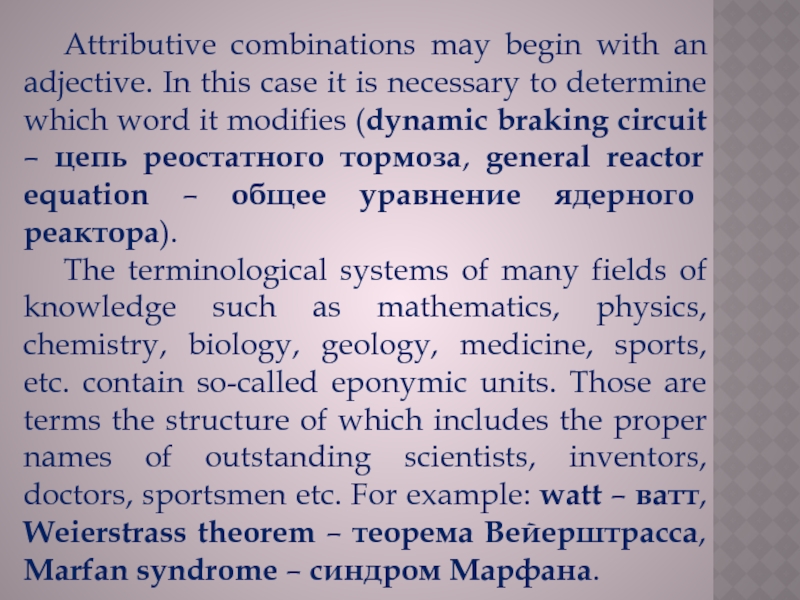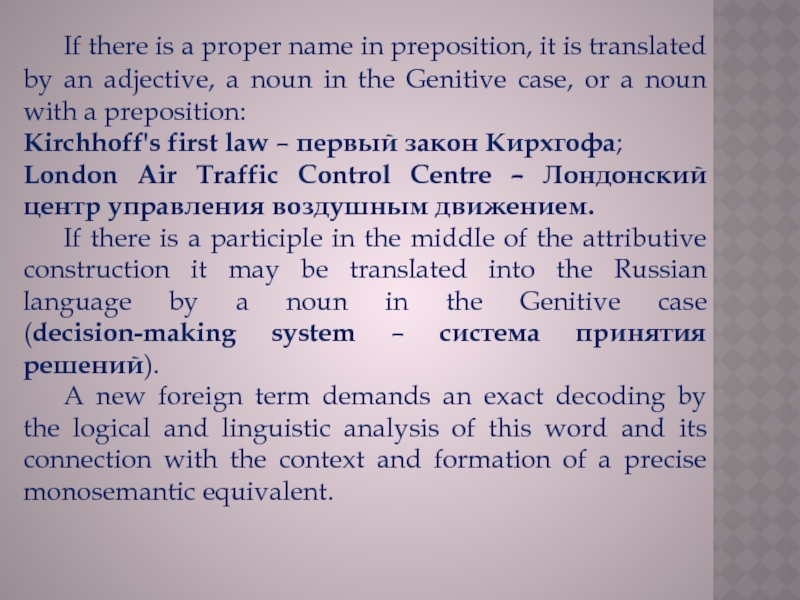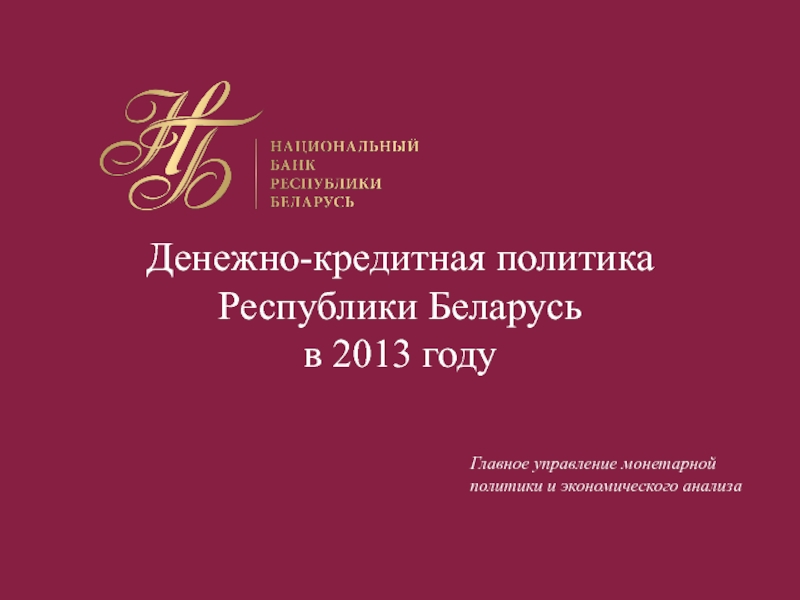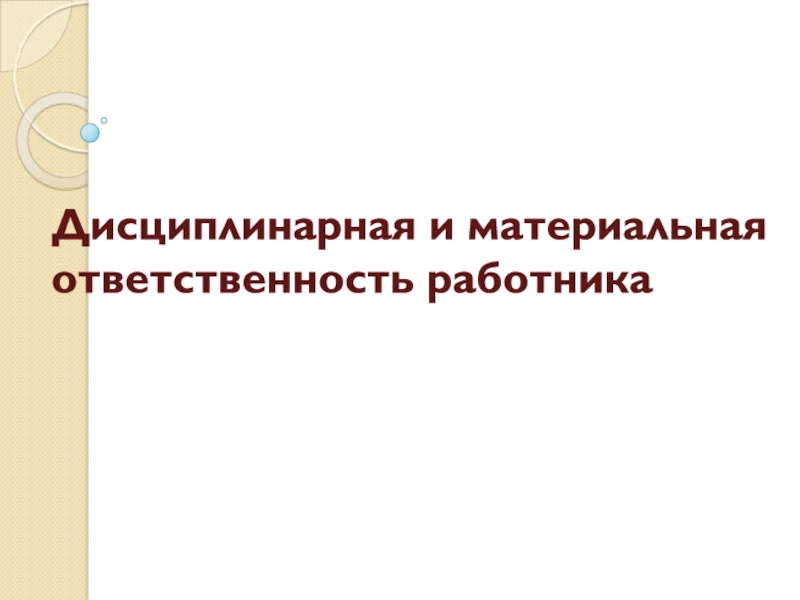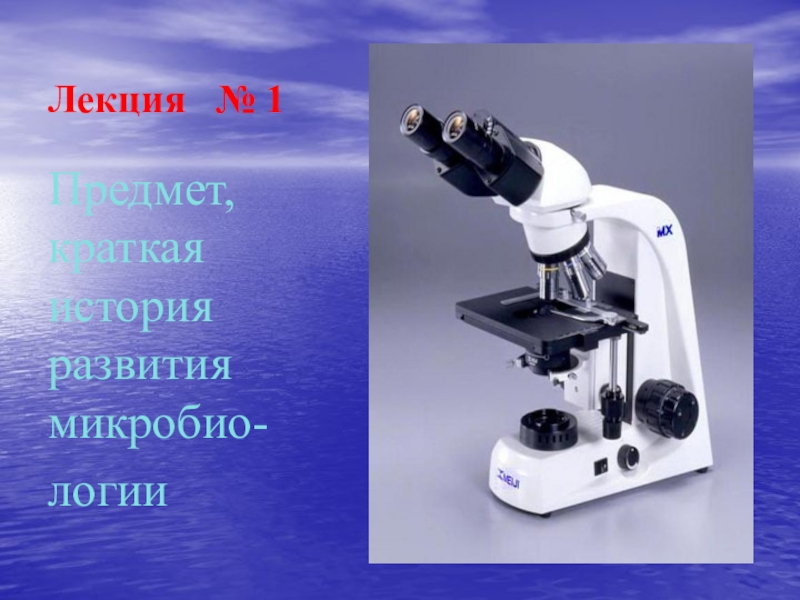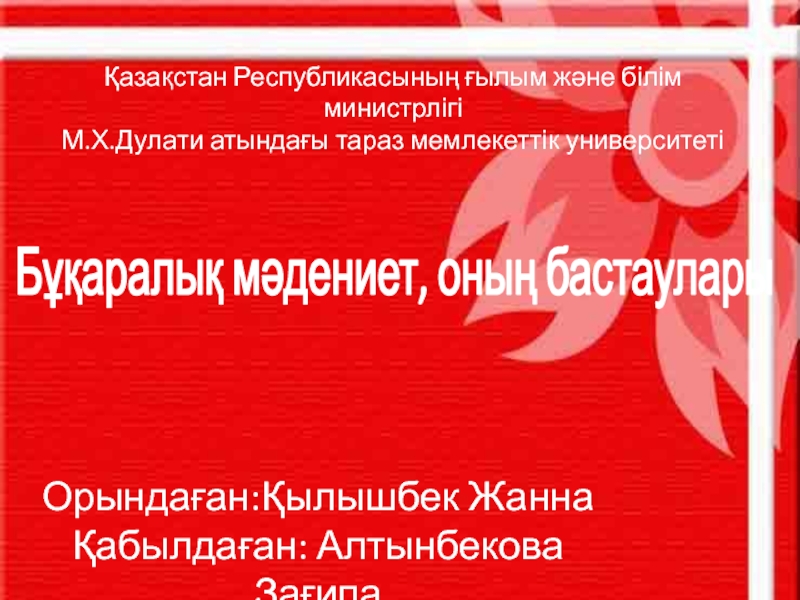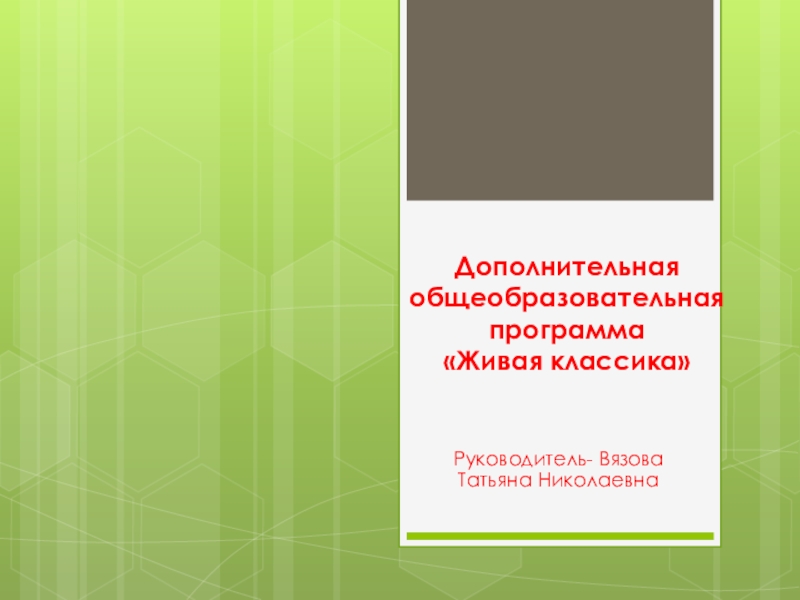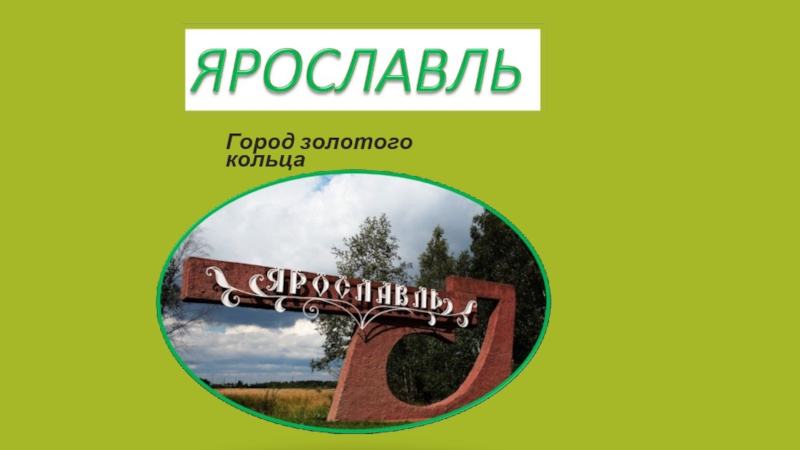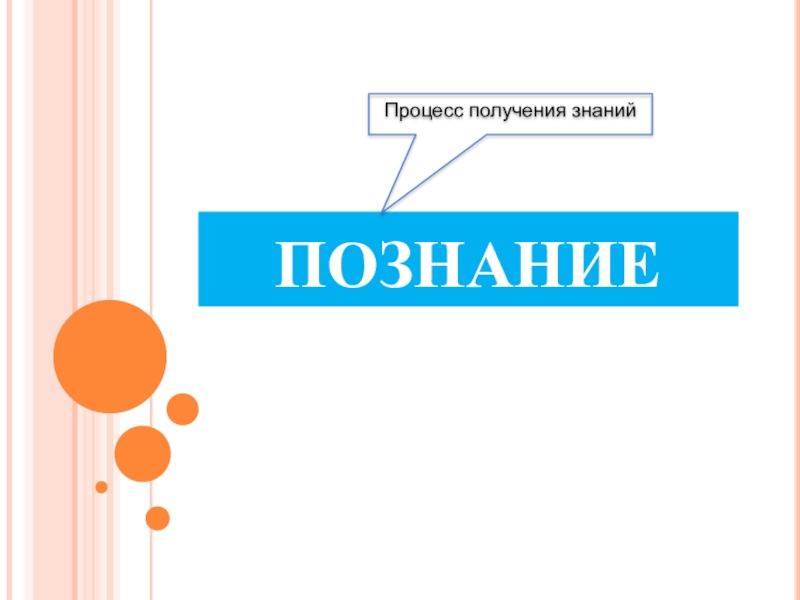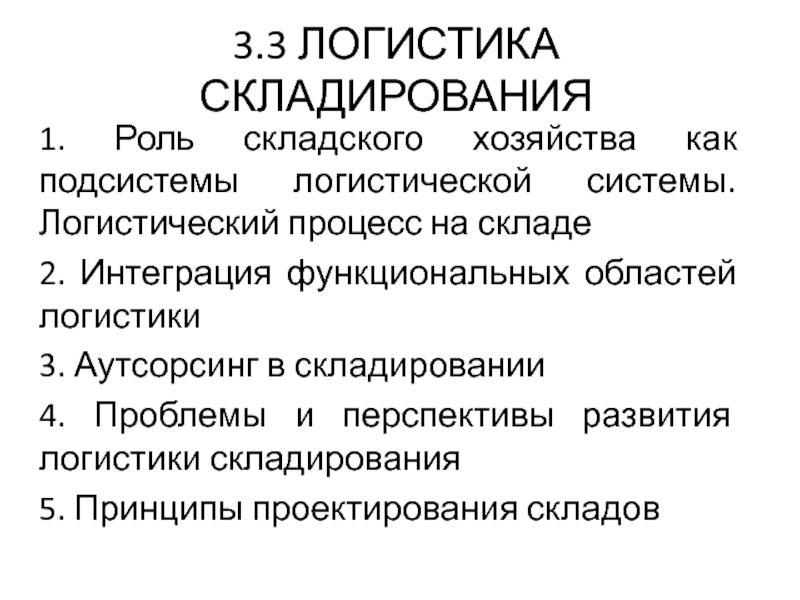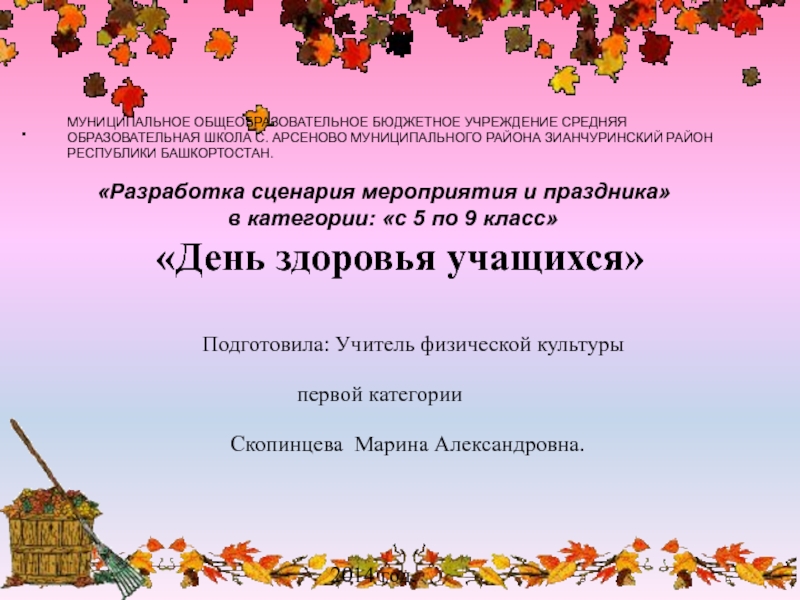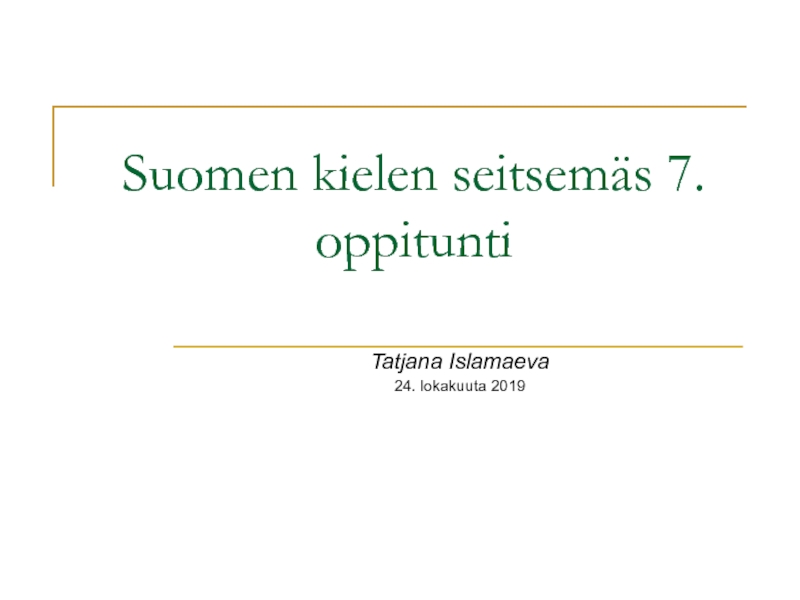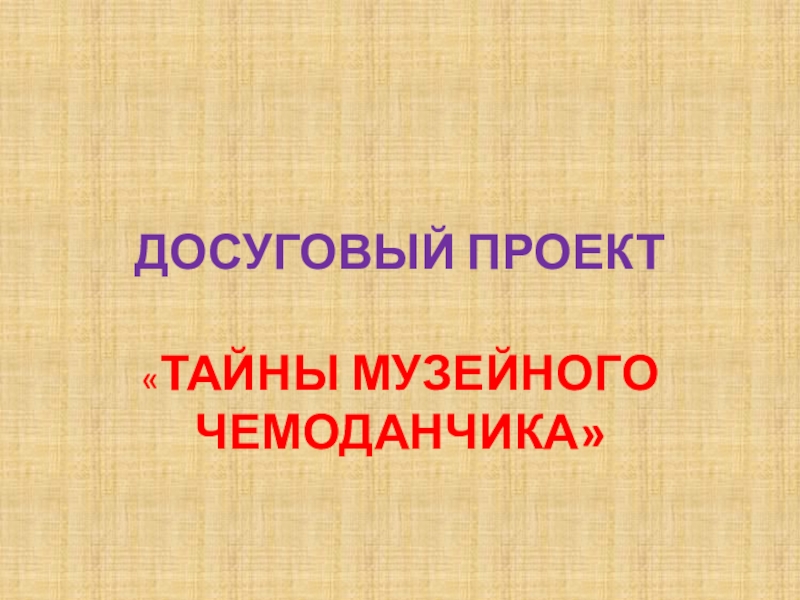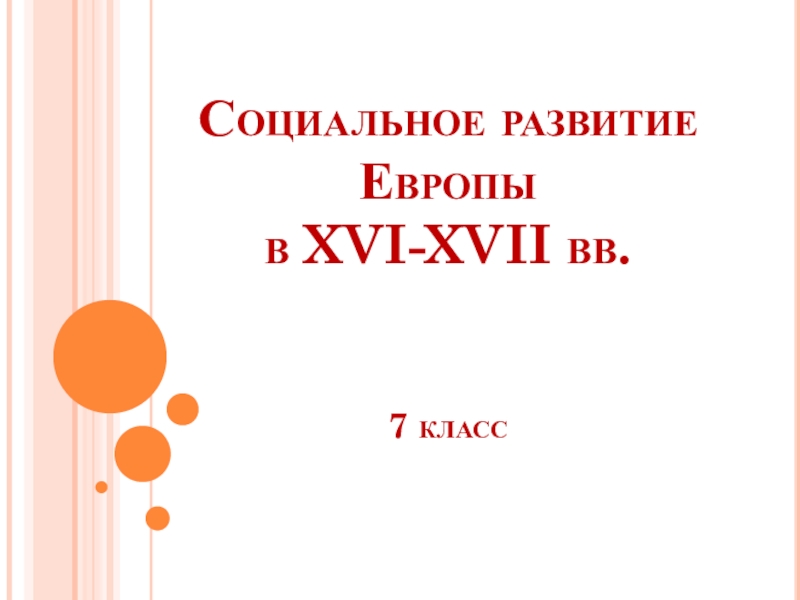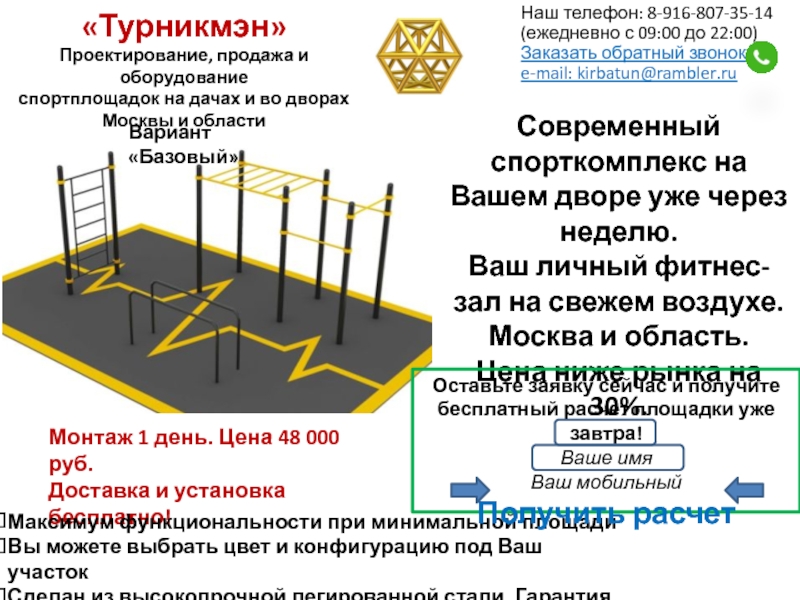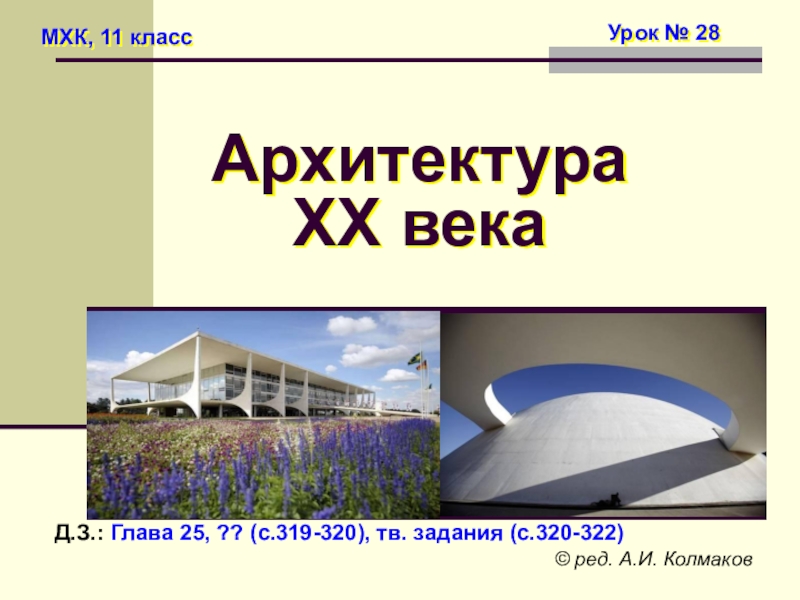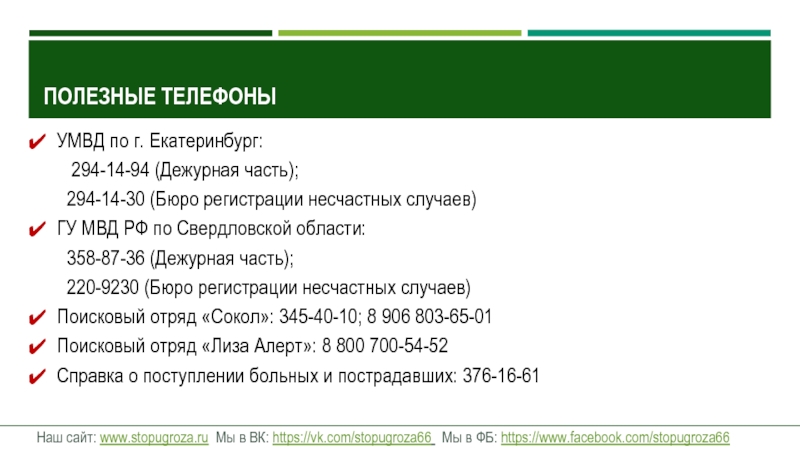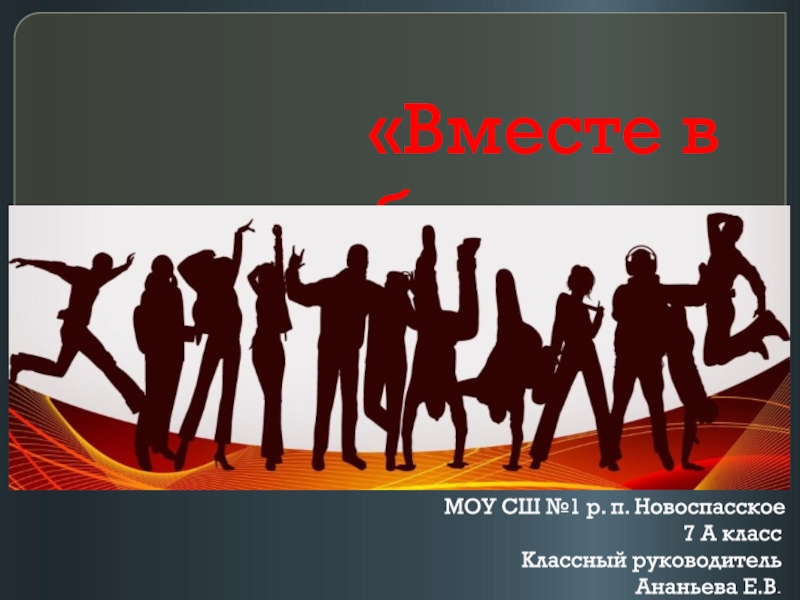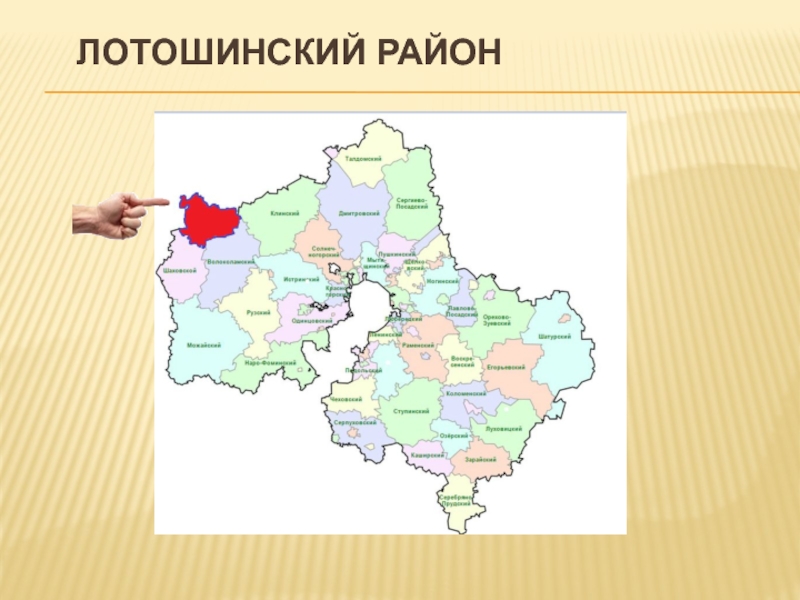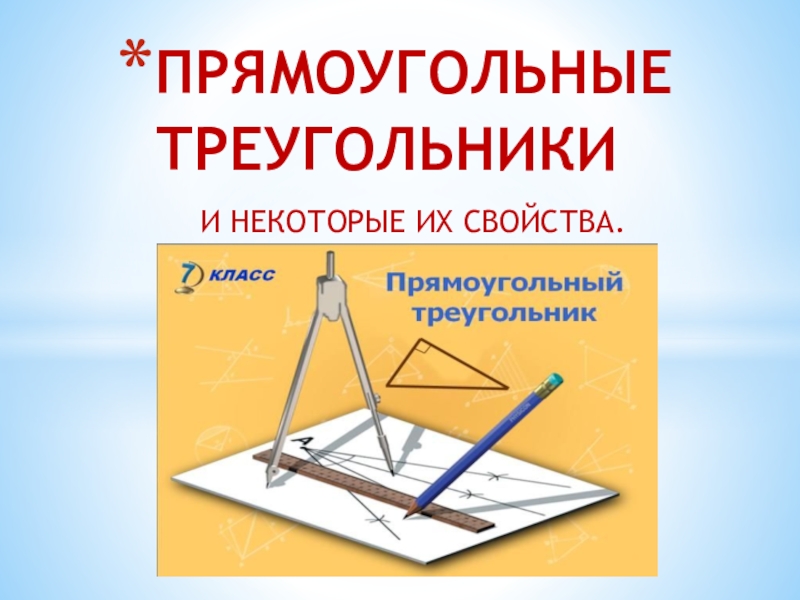Слайд 1Lectures 6-7
Translation
of Terms
Слайд 2 Translation of scientific and technical terms is absolutely dependent on
the translator’s knowledge of the subject matter of the source
text. Translators should get familiar with the system of terms in the corresponding sphere and make good use of terminological dictionaries and other books of reference, as well as online resources.
It is necessary to remember that a term is usually translated by a corresponding term of the target language. Such ways of translation as use of analogues, using synonyms and descriptive translation are applied only when there are no equivalent terms in the target language.
Слайд 3 To do accurate translation, it is necessary not only to
know the meaning of the terms but also to link
them with other words in speech. A word combination used incorrectly can lead to difficulties in understanding the text. For example, the word combination прозвонить цепь cannot be rendered by its calque to ring through the line. Its equivalent is to test the line. Therefore, translators always make use of dictionaries containing terminological word-groupsand illustrating sentences containing a necessary term.
Слайд 4 Translation is also challenged by term homonymy. A translator must
be aware of the exact meaning of term in the
respective sphere, as well as its combinability, for the attribute or another neighbouring word may specify the term and affect its translation: антикоррозийное покрытие – corrosion-resistant coating, дерновое покрытие – sod-matting, дорожное покрытие – road pavement, покрытие крыши – roofing, маскировочное покрытие – camouflage cover, пенное покрытие – foam blanket.
Terms are relatively context-free language units though the context often helps to identify the specific field to which the term belongs. As a rule, English technical and scientific terms have their permanent equivalents in the respective Russian terminological systems: heater – нагревательный прибор; alkaline medium – щелочная среда; silicic acid – кремниевая кислота; spherical shell – сферическая оболочка.
Слайд 5 Many Russian equivalents have been formed from the English terms
by transcription or loan translations: container – контейнер, file –
файл, design – дизайн. Terminologies possess international units: atom – атом, proton – протон, focus – фокус, plus – плюс, diode – диод. In some cases there are parallel forms in Russian: one formed by transcription (a loan-word) and the other, which is usually a native word, e.g.: эквивалентность равенство; баланс and равновесие; резистор and сопротивление; бустер and ускоритель; индустрия and промышленность, коммерция and торговля.
For translators it’s absolutely necessary to make the correct choice in such cases.
They should take into account whether the source text is highly technical or not, as a borrowed term is usually more familiar to specialists than to laymen. They have also to take into consideration the possible differences between the two forms in the way they are used in the target language. For example, the Russian word индустрия is restricted in usage and somewhat old-fashioned.
Слайд 6 When it comes to the selection between a loan form
and its analog, authors would prefer a form clearer to
the receptor. For example, whereas medical professionals would use the word летальный, journalists and writers would rather write смертельный to render lethal. Similarly, the equivalents to the term hemostasis would be split for two registers: гемостаз used in medicine, and остановка кровотечения used for a common receptor.
Term translation may also depend on the regional character of the language. For example, антенна corresponds to aerial in British English, to antenna in American English; ветровое стекло (автомобиля) – windscreen (British English), windshield (American English); багажник (автомобиля) – boot (British), trunk (American).
Слайд 7 Term translation depends on the register it is used in.
In science, translators tend to translate as precisely as possible.
Absolute equivalence of terms is a requirement in scientific translation. In other registers, term translation depends on the receptors background, and on the function the term plays in the text.
From the point of view of understanding and translation difficulty terms may be classified into three groups:
1. Terms denoting realia of other countries. Several ways of translation are possible: a) by a Russian term, the form of which is connected with a form of an English word (international terms); b) by a Russian term, the form of which is not connected with a form of an English term; c) the meaning of a multi-word English term has a fully equivalent Russian term; d) the general meaning of a multi-word term coincides with the meaning of an analogous Russian term, but their components are different.
Слайд 82. Terms denoting realia of other countries, but having generally
accepted Russian terminological equivalents.
3. Terms denoting realia of other
countries and not having generally accepted Russian terminological equivalents. Translation of such terms may be done in the following ways: а) description of an English term; b) word-for-word translation; c) partial or full transliteration; d) transliteration and word-for-word translation; e) transcription; f) transcription and translation.
Слайд 9 It is necessary to mention that the main mistake in
translation of such terms is that translators sometimes try to
find a literal equivalent of the English term in Russian materials. Such an approach is not completely correct as it is important to render the specific character of foreign realia. Furthermore, these terms may express concepts typical only of foreign reality and, consequently, they may not correspond to the realia accepted in Russian special texts. Translators can also make a mistake as a result of wrong referring of a term to one of the groups mentioned above and choice of an inadequate way of translation.
Слайд 10 One more translator’s mistake is word-for-word translation when an English
term or its components are analogous to a Russian term,
but they have another meaning. In translation it is necessary to take into consideration the meaning of the term in the particular situation and concrete context. It is also necessary to take into account the possible changes of the term’s meaning if it is used in the Plural form.
Thus, correct understanding and translation of terms depend not only on good knowledge of the language, but also on being aware of foreign and Russian realia.
Слайд 11The main ways of translating terms
Слайд 12transcription
Is used for loan terms: display – дисплей, algorithm –
алгоритм, phenomenon – феномен. Care should be taken not to
overuse this technique. Terms may not survive in the borrowed form, as happened with the computer term hardware whose loan equivalent хардвер is no longer used in computer science, but has given way to its explanatory substitution: электромеханическое оборудование, техническое обеспечение.
Слайд 13transliteration
For example: carbide – карбид, function – функция. Normally, terms
are transliterated or transcribed when a target language lacks a
certain notion and borrows it a short foreign form.
Many international loan terms are of Greek or Latin origin. This facilitates mutual understanding among specialists: arthrogryposis – артрогрипоз, osteodystrophy – остеодистрофия, hematoma – гематома.
Слайд 14 However, when using this technique a translator should be aware
of ‘false friends’, that is words similar in form but
different in meaning, for example: benzene in chemistry is equal to бензол, not бензин, the latter corresponding to benzine, gasoline. Likewise, мутиляция = отторжение части тела или органа – rejection, mutilation – увечье, калечащее повреждение; hemeralopia – дневная слепота (ухудшение зрения при дневном свете), гемералопия = ночная (куриная) слепота – nyctalopia.
A translator of science texts must use only standard terms, avoiding slang or colloquial words. For instance, brown coal – бурый уголь (not коричневый уголь); natural gas – природный газ (not натуральный газ); airplane – самолет (not аэроплан); машинное масло – engine oil (not machine oil).
Слайд 15Calque, half-calque
This technique is often applied to translating compound terms
or term phrases: preanalysis – преданализ; structural system analysis –
структурный системный анализ; address field – поле адреса; one-dimensional – одномерный.
This translation technique, even more than transcription or transliteration, may be detrimental to the correctness of the meaning, for it can lead to “false friends”: letter-of-credit is not письмо доверия but аккредитив; песочные часы – not *sand clock but hour-glass; цветные металлы – not *colored metals but non-ferrous metals. Transparent inner form of the word can cause no less trouble with translation equivalents: gooseberry – крыжовник (not гусиная ягода), quicksilver – ртуть (not быстрое серебро), bear’s onion – черемша (not медвежий лук).
Слайд 16Translating a word and using it as a term
For example:
mouse – мышь, net – сеть, memory – память. Gradually,
specialists get accustomed to these terms and use them widely in speech.
Слайд 17Explicatory (descriptive) translation and expansion
This technique is used for verbalizing
new objects, not existing in the target language. For example,
open housing – жилищная политика равных возможностей, tripos – экзамен для получения отличия в Кембридже. It is desirable that a translator avoid translating a descriptive by a transliterated (technical) term for the purpose of “showing off” knowledge. However, the descriptive technique is justified by the lack of an appropriate technical term in the source language. In English-to-Russian translation, a more explicit character of the Russian language can necessitate the descriptive technique: radarproof – защищенный от радиолокационного обнаружения, conflict of interest – злоупотребление служебным положением.
Слайд 18reduction
Reduction takes place when one word or a smaller number
of words verbalizes a notion: computer engineer – электроник, earnings
report – счет прибылей и убытков компании. To make sure that the term is standard, it is necessary to consult the dictionary as often as possible.
Слайд 19Analogue substitution
Analogue substitution: cold cereal – сухой завтрак, play school
– детские ясли. This technique is used for a receptor’s
convenience when corresponding similar standard terms exist in the target language.
From the point of view of its structure a term may 1) consist of one word or 2) be a word-group consisting of one key-word and one or several adjuncts specifying or modifying the meaning of the term. Such terms are widespread and may cause difficulties while translating. These combinations may consist of two or more elements.
Слайд 20
а. A word-group consisting of two words. The first element
may be translated into Russian in different ways:
1. by an
adjective (distribution shaft – распределительный вал; fuel cock – топливный кран);
2. by a noun in the Genitive case (isobutylene oxide – оксид изобутилена; failure detection – обнаружение неисправностей; accumulator cell – элемент аккумулятора; land retirement – эрозия почвы, выдувание почвы);
3. by a noun with a preposition (split burner – горелка с рассекателем, carbon cloth – ткань из углеродного волокна).
Слайд 21
4. by a compound (development engineer – инженер-разработчик; electrical engineer
– инженер-электрик);
5. by a participial construction (unbounded coating – многослойная
изоляция (трубопровода), состоящая из несвязанных между собой слоёв; designed experiment – эксперимент, проводимый по заранее составленной программе);
6. by other descriptive means (squawk altimeter – высотомер, показания которого выведены в ответчик; square engine – двигатель, в котором диаметр цилиндра равен ходу поршня).
Слайд 22b. A word-group consisting of several components. Translating such kind
of combinations it is necessary to keep to the following
succession of actions:
1. translate the dependent noun (the last word of the word-group);
2. analyse the semantic relations between the members of the word-group and divide them into sense-groups (it should be analysed from left to right);
3. translate the word-group beginning with the dependent word and then translate every sense group from right to left.
Слайд 23For instance, sample data transmission station
1. Translate the last
word станция.
2. Divide the whole word-combination into sense-groups: 1. sample
data 2. transmission station
3. Translation: станция передачи выборочных данных.
Car speed calculation problem – проблема вычисления скорости автомобиля.
Слайд 24 Attributive combinations may begin with an adjective. In this case
it is necessary to determine which word it modifies (dynamic
braking circuit – цепь реостатного тормоза, general reactor equation – общее уравнение ядерного реактора).
The terminological systems of many fields of knowledge such as mathematics, physics, chemistry, biology, geology, medicine, sports, etc. contain so-called eponymic units. Those are terms the structure of which includes the proper names of outstanding scientists, inventors, doctors, sportsmen etc. For example: watt – ватт, Weierstrass theorem – теорема Вейерштрасса, Marfan syndrome – синдром Марфана.
Слайд 25 If there is a proper name in preposition, it is
translated by an adjective, a noun in the Genitive case,
or a noun with a preposition:
Kirchhoff's first law – первый закон Кирхгофа;
London Air Traffic Control Centre – Лондонский центр управления воздушным движением.
If there is a participle in the middle of the attributive construction it may be translated into the Russian language by a noun in the Genitive case (decision-making system – система принятия решений).
A new foreign term demands an exact decoding by the logical and linguistic analysis of this word and its connection with the context and formation of a precise monosemantic equivalent.
